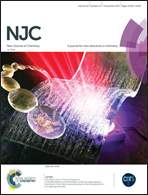Supramolecular complexes formed by dimethoxypillar[5]arenes and imidazolium salts: a joint experimental and computational investigation†
Abstract
To gain more insights into the factors acting on the stability of complexes formed by pillar[5]arenes, we investigated the interaction of dimethoxypillar[5]arene with some 1-(n-alkyl)-3-(9-anthracenylmethyl)-imidazolium based organic salts. In particular, we used salts differing in not only the anion nature ([Cl−], [BF4−], [NTf2−] and [SbF6−]) and alkyl chain length (butyl, octyl and dodecylimidazolium derivatives), but also the presence of a hydrogenated or fluorinated tail (octyl and perfluorooctylimidazolium derivatives). Host–guest systems were analysed in solution, solid state and gas phase, using a combined approach of different techniques like fluorescence, 1H NMR, ESI-MS, DSC and DFT calculations. Data collected show that the complex stability is heavily affected by solvent nature. Furthermore, solvent being the same, it increases with the decrease of the alkyl chain length and the anion coordination ability. The joint information obtained from 1H NMR and DFT calculations allows drawing a picture of the complex geometry. On the other hand, fluorescence investigation on the solid state evidences the occurrence of an aggregation enhanced emission process for these systems.
![Graphical abstract: Supramolecular complexes formed by dimethoxypillar[5]arenes and imidazolium salts: a joint experimental and computational investigation](/en/Image/Get?imageInfo.ImageType=GA&imageInfo.ImageIdentifier.ManuscriptID=C7NJ02598J&imageInfo.ImageIdentifier.Year=2017)


 Please wait while we load your content...
Please wait while we load your content...